CHCCCS011 Learner Guide: Mastering Personal Support Needs Skills
VerifiedAdded on 2023/06/10
|41
|9675
|136
Homework Assignment
AI Summary
This document is a CHCCCS011 learner workbook designed to guide students in understanding and meeting personal support needs within a healthcare setting. It includes instructions, assessment tasks, and activities to test knowledge and skills related to the competency. The workbook outlines assessment requirements, competency outcomes, and policies regarding assessment appeals, special needs, confidentiality, and academic misconduct. Activities range from identifying individual needs and providing appropriate support to understanding legal and ethical considerations. The document also contains checklists for assessors and supplementary oral questions to ensure comprehensive evaluation. Desklib provides a platform for students to access this and other solved assignments, along with past papers, to aid in their studies.
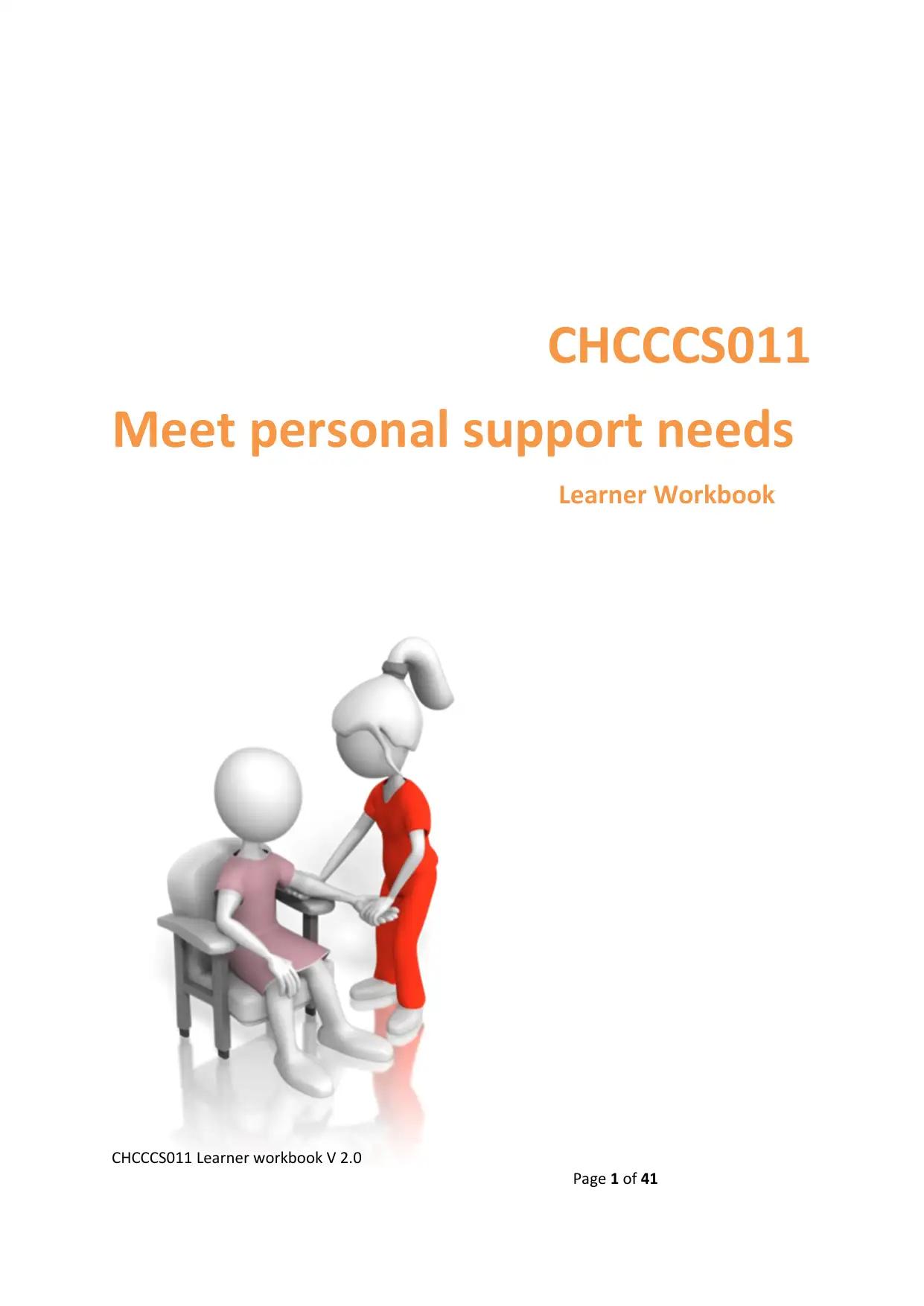
CHCCCS011
Meet personal support needs
Learner Workbook
CHCCCS011 Learner workbook V 2.0
Page 1 of 41
Meet personal support needs
Learner Workbook
CHCCCS011 Learner workbook V 2.0
Page 1 of 41
Paraphrase This Document
Need a fresh take? Get an instant paraphrase of this document with our AI Paraphraser
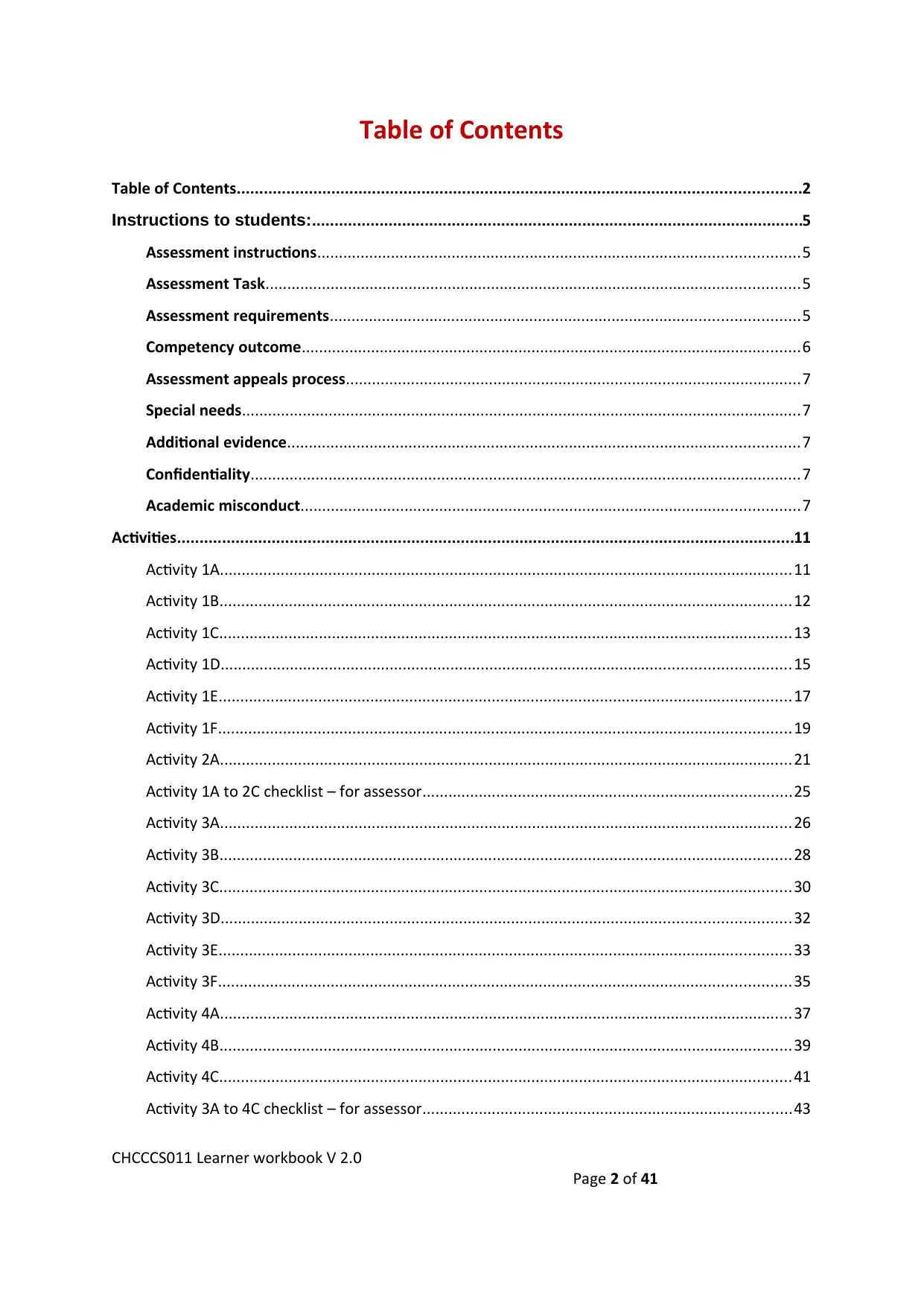
Table of Contents
Table of Contents.............................................................................................................................2
Instructions to students:.............................................................................................................5
Assessment instructions...............................................................................................................5
Assessment Task...........................................................................................................................5
Assessment requirements............................................................................................................5
Competency outcome...................................................................................................................6
Assessment appeals process.........................................................................................................7
Special needs.................................................................................................................................7
Additional evidence......................................................................................................................7
Confidentiality...............................................................................................................................7
Academic misconduct...................................................................................................................7
Activities.........................................................................................................................................11
Activity 1A....................................................................................................................................11
Activity 1B....................................................................................................................................12
Activity 1C....................................................................................................................................13
Activity 1D...................................................................................................................................15
Activity 1E....................................................................................................................................17
Activity 1F....................................................................................................................................19
Activity 2A....................................................................................................................................21
Activity 1A to 2C checklist – for assessor.....................................................................................25
Activity 3A....................................................................................................................................26
Activity 3B....................................................................................................................................28
Activity 3C....................................................................................................................................30
Activity 3D...................................................................................................................................32
Activity 3E....................................................................................................................................33
Activity 3F....................................................................................................................................35
Activity 4A....................................................................................................................................37
Activity 4B....................................................................................................................................39
Activity 4C....................................................................................................................................41
Activity 3A to 4C checklist – for assessor.....................................................................................43
CHCCCS011 Learner workbook V 2.0
Page 2 of 41
Table of Contents.............................................................................................................................2
Instructions to students:.............................................................................................................5
Assessment instructions...............................................................................................................5
Assessment Task...........................................................................................................................5
Assessment requirements............................................................................................................5
Competency outcome...................................................................................................................6
Assessment appeals process.........................................................................................................7
Special needs.................................................................................................................................7
Additional evidence......................................................................................................................7
Confidentiality...............................................................................................................................7
Academic misconduct...................................................................................................................7
Activities.........................................................................................................................................11
Activity 1A....................................................................................................................................11
Activity 1B....................................................................................................................................12
Activity 1C....................................................................................................................................13
Activity 1D...................................................................................................................................15
Activity 1E....................................................................................................................................17
Activity 1F....................................................................................................................................19
Activity 2A....................................................................................................................................21
Activity 1A to 2C checklist – for assessor.....................................................................................25
Activity 3A....................................................................................................................................26
Activity 3B....................................................................................................................................28
Activity 3C....................................................................................................................................30
Activity 3D...................................................................................................................................32
Activity 3E....................................................................................................................................33
Activity 3F....................................................................................................................................35
Activity 4A....................................................................................................................................37
Activity 4B....................................................................................................................................39
Activity 4C....................................................................................................................................41
Activity 3A to 4C checklist – for assessor.....................................................................................43
CHCCCS011 Learner workbook V 2.0
Page 2 of 41

Summative Assessments................................................................................................................44
Supplementary Oral Questions (optional) – for assessor................................................................46
CHCCCS011 Learner workbook V 2.0
Page 3 of 41
Supplementary Oral Questions (optional) – for assessor................................................................46
CHCCCS011 Learner workbook V 2.0
Page 3 of 41
⊘ This is a preview!⊘
Do you want full access?
Subscribe today to unlock all pages.

Trusted by 1+ million students worldwide

CHCCCS011 Learner workbook V 2.0
Page 4 of 41
Page 4 of 41
Paraphrase This Document
Need a fresh take? Get an instant paraphrase of this document with our AI Paraphraser
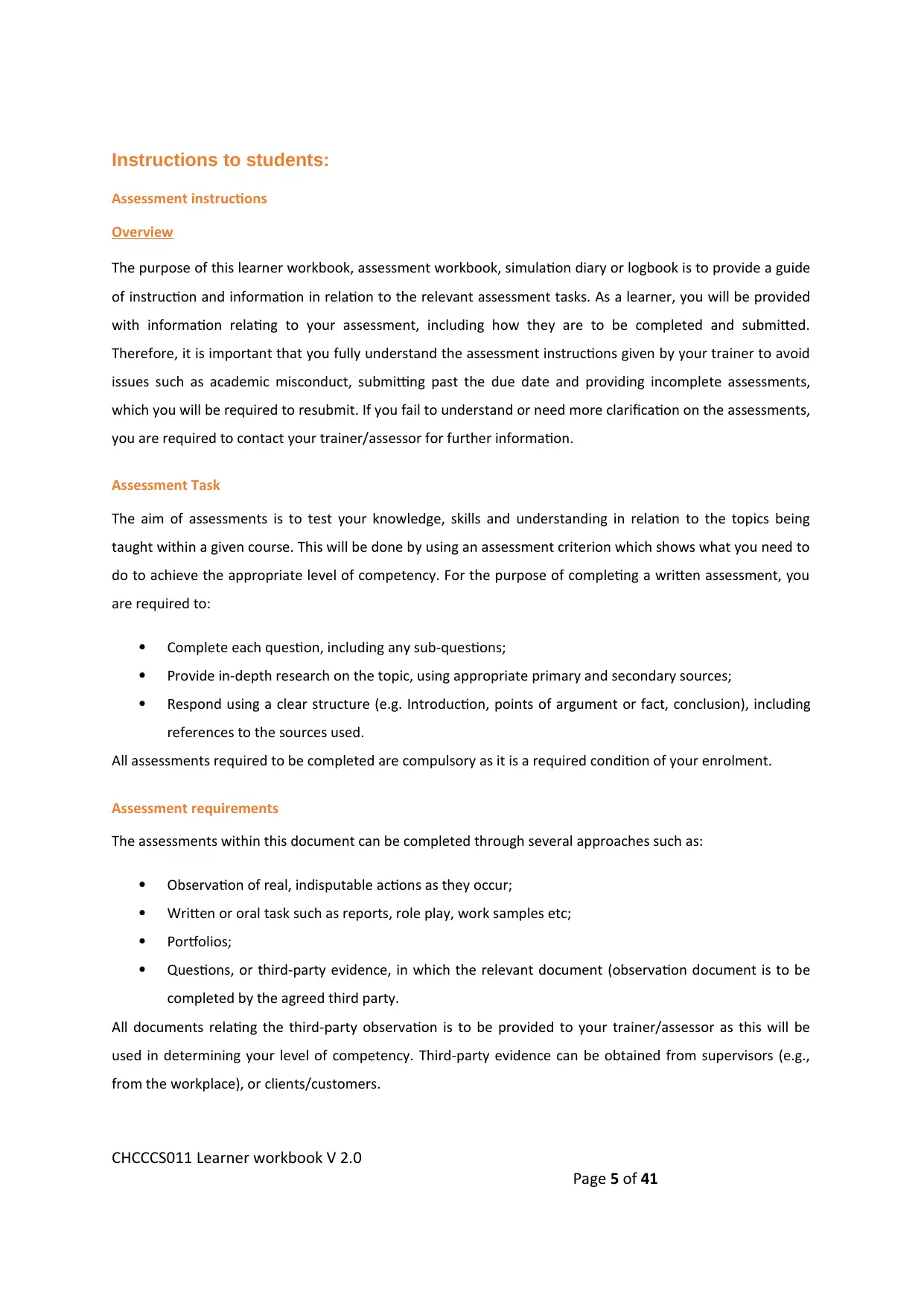
Instructions to students:
Assessment instructions
Overview
The purpose of this learner workbook, assessment workbook, simulation diary or logbook is to provide a guide
of instruction and information in relation to the relevant assessment tasks. As a learner, you will be provided
with information relating to your assessment, including how they are to be completed and submitted.
Therefore, it is important that you fully understand the assessment instructions given by your trainer to avoid
issues such as academic misconduct, submitting past the due date and providing incomplete assessments,
which you will be required to resubmit. If you fail to understand or need more clarification on the assessments,
you are required to contact your trainer/assessor for further information.
Assessment Task
The aim of assessments is to test your knowledge, skills and understanding in relation to the topics being
taught within a given course. This will be done by using an assessment criterion which shows what you need to
do to achieve the appropriate level of competency. For the purpose of completing a written assessment, you
are required to:
Complete each question, including any sub-questions;
Provide in-depth research on the topic, using appropriate primary and secondary sources;
Respond using a clear structure (e.g. Introduction, points of argument or fact, conclusion), including
references to the sources used.
All assessments required to be completed are compulsory as it is a required condition of your enrolment.
Assessment requirements
The assessments within this document can be completed through several approaches such as:
Observation of real, indisputable actions as they occur;
Written or oral task such as reports, role play, work samples etc;
Portfolios;
Questions, or third-party evidence, in which the relevant document (observation document is to be
completed by the agreed third party.
All documents relating the third-party observation is to be provided to your trainer/assessor as this will be
used in determining your level of competency. Third-party evidence can be obtained from supervisors (e.g.,
from the workplace), or clients/customers.
CHCCCS011 Learner workbook V 2.0
Page 5 of 41
Assessment instructions
Overview
The purpose of this learner workbook, assessment workbook, simulation diary or logbook is to provide a guide
of instruction and information in relation to the relevant assessment tasks. As a learner, you will be provided
with information relating to your assessment, including how they are to be completed and submitted.
Therefore, it is important that you fully understand the assessment instructions given by your trainer to avoid
issues such as academic misconduct, submitting past the due date and providing incomplete assessments,
which you will be required to resubmit. If you fail to understand or need more clarification on the assessments,
you are required to contact your trainer/assessor for further information.
Assessment Task
The aim of assessments is to test your knowledge, skills and understanding in relation to the topics being
taught within a given course. This will be done by using an assessment criterion which shows what you need to
do to achieve the appropriate level of competency. For the purpose of completing a written assessment, you
are required to:
Complete each question, including any sub-questions;
Provide in-depth research on the topic, using appropriate primary and secondary sources;
Respond using a clear structure (e.g. Introduction, points of argument or fact, conclusion), including
references to the sources used.
All assessments required to be completed are compulsory as it is a required condition of your enrolment.
Assessment requirements
The assessments within this document can be completed through several approaches such as:
Observation of real, indisputable actions as they occur;
Written or oral task such as reports, role play, work samples etc;
Portfolios;
Questions, or third-party evidence, in which the relevant document (observation document is to be
completed by the agreed third party.
All documents relating the third-party observation is to be provided to your trainer/assessor as this will be
used in determining your level of competency. Third-party evidence can be obtained from supervisors (e.g.,
from the workplace), or clients/customers.
CHCCCS011 Learner workbook V 2.0
Page 5 of 41
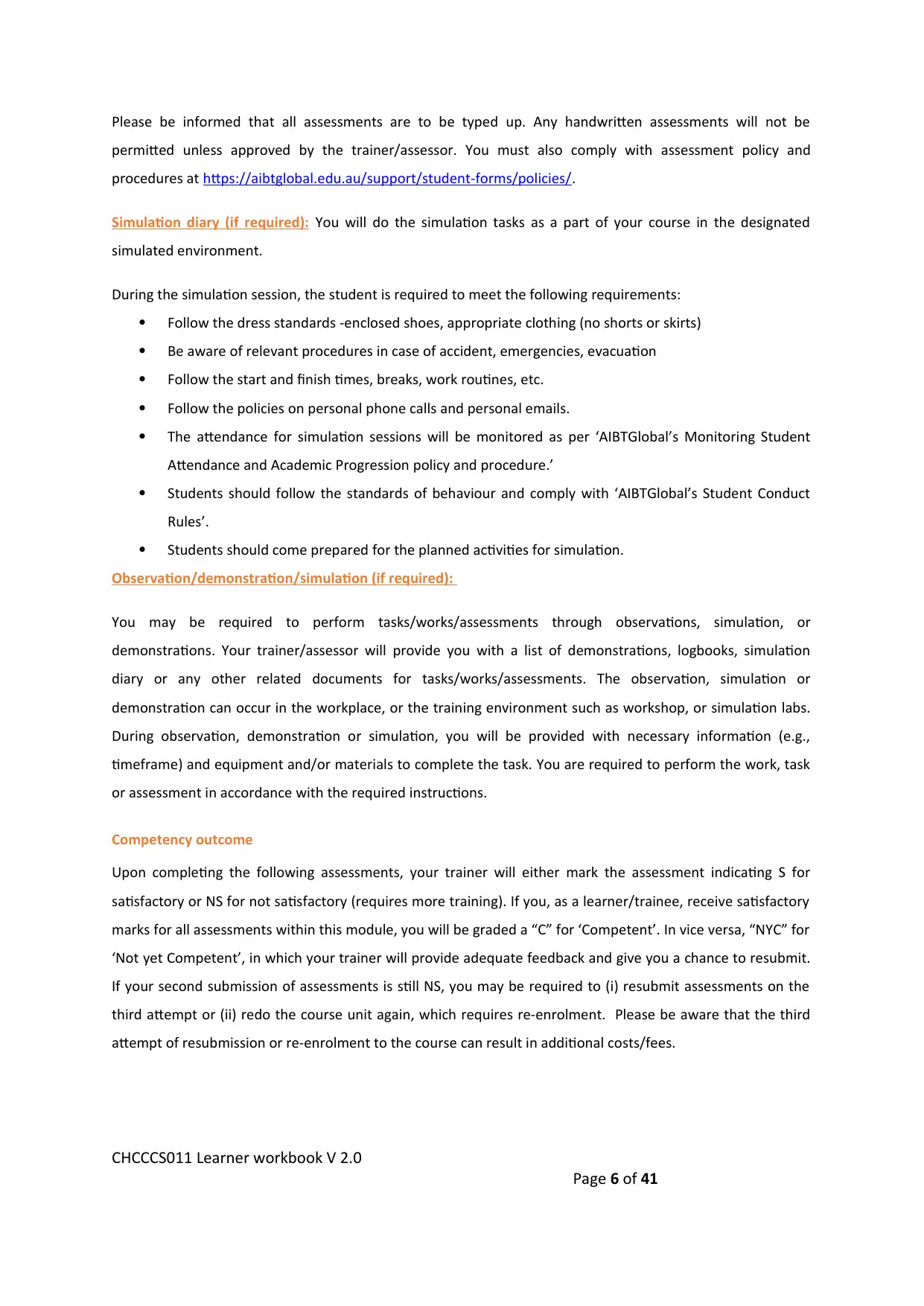
Please be informed that all assessments are to be typed up. Any handwritten assessments will not be
permitted unless approved by the trainer/assessor. You must also comply with assessment policy and
procedures at https://aibtglobal.edu.au/support/student-forms/policies/.
Simulation diary (if required): You will do the simulation tasks as a part of your course in the designated
simulated environment.
During the simulation session, the student is required to meet the following requirements:
Follow the dress standards -enclosed shoes, appropriate clothing (no shorts or skirts)
Be aware of relevant procedures in case of accident, emergencies, evacuation
Follow the start and finish times, breaks, work routines, etc.
Follow the policies on personal phone calls and personal emails.
The attendance for simulation sessions will be monitored as per ‘AIBTGlobal’s Monitoring Student
Attendance and Academic Progression policy and procedure.’
Students should follow the standards of behaviour and comply with ‘AIBTGlobal’s Student Conduct
Rules’.
Students should come prepared for the planned activities for simulation.
Observation/demonstration/simulation (if required):
You may be required to perform tasks/works/assessments through observations, simulation, or
demonstrations. Your trainer/assessor will provide you with a list of demonstrations, logbooks, simulation
diary or any other related documents for tasks/works/assessments. The observation, simulation or
demonstration can occur in the workplace, or the training environment such as workshop, or simulation labs.
During observation, demonstration or simulation, you will be provided with necessary information (e.g.,
timeframe) and equipment and/or materials to complete the task. You are required to perform the work, task
or assessment in accordance with the required instructions.
Competency outcome
Upon completing the following assessments, your trainer will either mark the assessment indicating S for
satisfactory or NS for not satisfactory (requires more training). If you, as a learner/trainee, receive satisfactory
marks for all assessments within this module, you will be graded a “C” for ‘Competent’. In vice versa, “NYC” for
‘Not yet Competent’, in which your trainer will provide adequate feedback and give you a chance to resubmit.
If your second submission of assessments is still NS, you may be required to (i) resubmit assessments on the
third attempt or (ii) redo the course unit again, which requires re-enrolment. Please be aware that the third
attempt of resubmission or re-enrolment to the course can result in additional costs/fees.
CHCCCS011 Learner workbook V 2.0
Page 6 of 41
permitted unless approved by the trainer/assessor. You must also comply with assessment policy and
procedures at https://aibtglobal.edu.au/support/student-forms/policies/.
Simulation diary (if required): You will do the simulation tasks as a part of your course in the designated
simulated environment.
During the simulation session, the student is required to meet the following requirements:
Follow the dress standards -enclosed shoes, appropriate clothing (no shorts or skirts)
Be aware of relevant procedures in case of accident, emergencies, evacuation
Follow the start and finish times, breaks, work routines, etc.
Follow the policies on personal phone calls and personal emails.
The attendance for simulation sessions will be monitored as per ‘AIBTGlobal’s Monitoring Student
Attendance and Academic Progression policy and procedure.’
Students should follow the standards of behaviour and comply with ‘AIBTGlobal’s Student Conduct
Rules’.
Students should come prepared for the planned activities for simulation.
Observation/demonstration/simulation (if required):
You may be required to perform tasks/works/assessments through observations, simulation, or
demonstrations. Your trainer/assessor will provide you with a list of demonstrations, logbooks, simulation
diary or any other related documents for tasks/works/assessments. The observation, simulation or
demonstration can occur in the workplace, or the training environment such as workshop, or simulation labs.
During observation, demonstration or simulation, you will be provided with necessary information (e.g.,
timeframe) and equipment and/or materials to complete the task. You are required to perform the work, task
or assessment in accordance with the required instructions.
Competency outcome
Upon completing the following assessments, your trainer will either mark the assessment indicating S for
satisfactory or NS for not satisfactory (requires more training). If you, as a learner/trainee, receive satisfactory
marks for all assessments within this module, you will be graded a “C” for ‘Competent’. In vice versa, “NYC” for
‘Not yet Competent’, in which your trainer will provide adequate feedback and give you a chance to resubmit.
If your second submission of assessments is still NS, you may be required to (i) resubmit assessments on the
third attempt or (ii) redo the course unit again, which requires re-enrolment. Please be aware that the third
attempt of resubmission or re-enrolment to the course can result in additional costs/fees.
CHCCCS011 Learner workbook V 2.0
Page 6 of 41
⊘ This is a preview!⊘
Do you want full access?
Subscribe today to unlock all pages.

Trusted by 1+ million students worldwide

Assessment appeals process
As a learner, you have a right to appeal a decision or outcome of an assessment if you feel like it was made
unfairly. However, this complaint must first be resolved with the trainer/assessor before lodging an appeal. If
you are still dissatisfied with the outcome, then a written application of the appeal can be made to the course
coordinator, outlining the grounds for the appeal in accordance with the complaints and appeals policy and
procedures at https://aibtglobal.edu.au/support/student-forms/policies/.
Special needs
Learning adjustments can be made for any candidate who has special needs (e.g., a student with a disability).
However, the trainer/assessor must be well informed about this so they can immediately implement the
necessary adjustments and have it ready before commencement.
Additional evidence
If at any event during or after the assessment process, the trainer/assessor requests you to provide additional
information or an alternative submission to establish your level of competency, then you are required to do so.
However, you must do so in a way that avoids any issues of privacy or confidentiality.
Confidentiality
All information provided to us regarding your job, workplace and employer will be kept confidential in
accordance with the relevant law. However, it is your responsibility to check that all information provided to us
does not involve details unrelated or not agreed upon for disclosure. For example, information about your
employer, colleagues and other related third parties who might be involved. Although we may require
information about these other parties, it is your responsibility to check that valid consent has been given from
these individuals before providing us with the requested information. This process of obtaining information
from the relevant parties must also be done in accordance with the relevant law.
Recognised prior learning
Any candidate may apply for credit transfer which they wish to count towards their course credit following the
application and assessment process of the credit transfer policy and procedure.
Academic misconduct
Academic Misconduct includes plagiarism, cheating and/or collusion, or any act or omission by a student which
attempts to circumvent or defeat the integrity of the College’s assessment process. Without limiting the scope
of the definition of academic misconduct, examples of plagiarism, cheating and collusion are provided below:
Plagiarism is defined as taking someone else’s work or ideas and submitting it as their own. This may include
acts such as, but not limited to:
CHCCCS011 Learner workbook V 2.0
Page 7 of 41
As a learner, you have a right to appeal a decision or outcome of an assessment if you feel like it was made
unfairly. However, this complaint must first be resolved with the trainer/assessor before lodging an appeal. If
you are still dissatisfied with the outcome, then a written application of the appeal can be made to the course
coordinator, outlining the grounds for the appeal in accordance with the complaints and appeals policy and
procedures at https://aibtglobal.edu.au/support/student-forms/policies/.
Special needs
Learning adjustments can be made for any candidate who has special needs (e.g., a student with a disability).
However, the trainer/assessor must be well informed about this so they can immediately implement the
necessary adjustments and have it ready before commencement.
Additional evidence
If at any event during or after the assessment process, the trainer/assessor requests you to provide additional
information or an alternative submission to establish your level of competency, then you are required to do so.
However, you must do so in a way that avoids any issues of privacy or confidentiality.
Confidentiality
All information provided to us regarding your job, workplace and employer will be kept confidential in
accordance with the relevant law. However, it is your responsibility to check that all information provided to us
does not involve details unrelated or not agreed upon for disclosure. For example, information about your
employer, colleagues and other related third parties who might be involved. Although we may require
information about these other parties, it is your responsibility to check that valid consent has been given from
these individuals before providing us with the requested information. This process of obtaining information
from the relevant parties must also be done in accordance with the relevant law.
Recognised prior learning
Any candidate may apply for credit transfer which they wish to count towards their course credit following the
application and assessment process of the credit transfer policy and procedure.
Academic misconduct
Academic Misconduct includes plagiarism, cheating and/or collusion, or any act or omission by a student which
attempts to circumvent or defeat the integrity of the College’s assessment process. Without limiting the scope
of the definition of academic misconduct, examples of plagiarism, cheating and collusion are provided below:
Plagiarism is defined as taking someone else’s work or ideas and submitting it as their own. This may include
acts such as, but not limited to:
CHCCCS011 Learner workbook V 2.0
Page 7 of 41
Paraphrase This Document
Need a fresh take? Get an instant paraphrase of this document with our AI Paraphraser
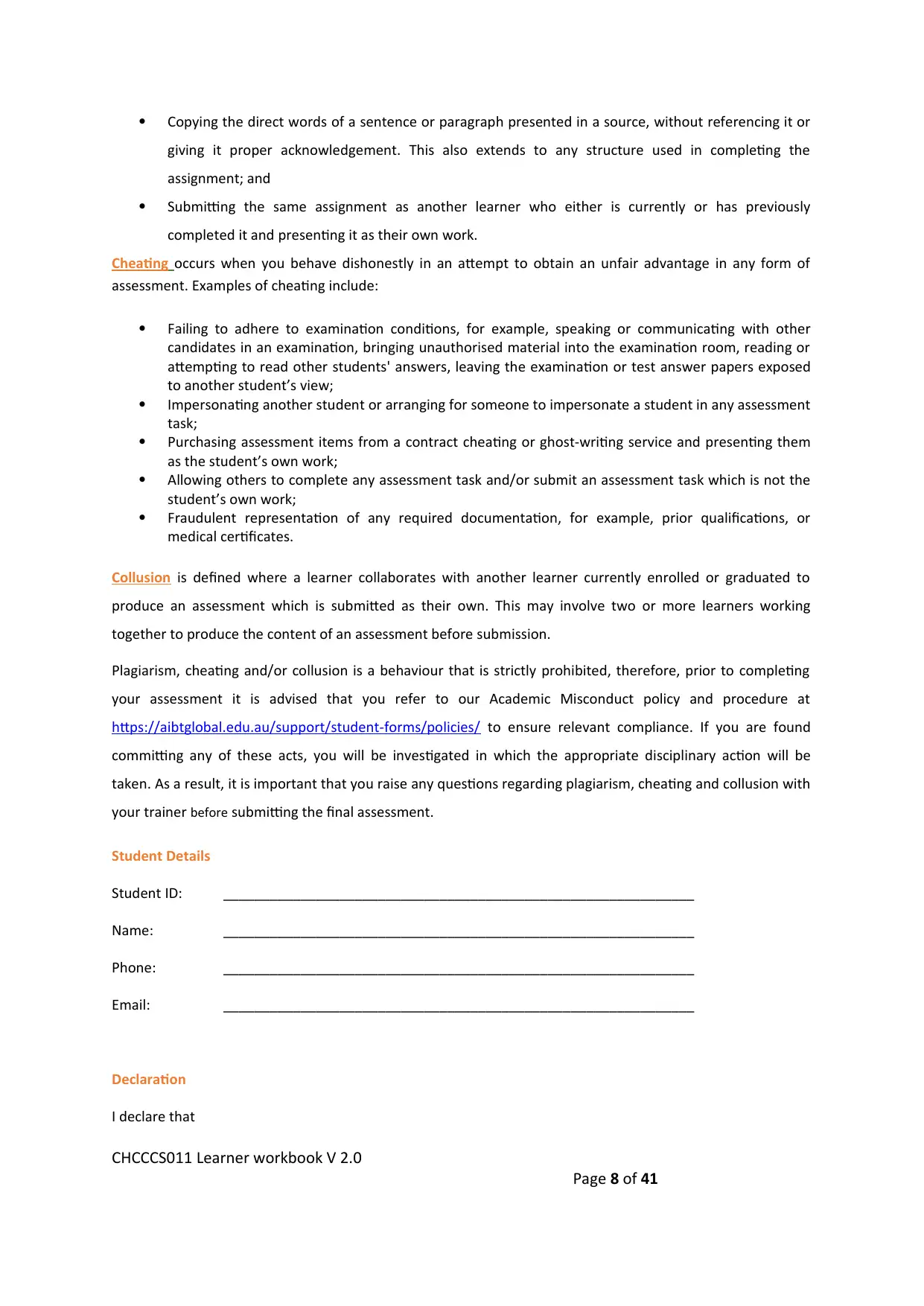
Copying the direct words of a sentence or paragraph presented in a source, without referencing it or
giving it proper acknowledgement. This also extends to any structure used in completing the
assignment; and
Submitting the same assignment as another learner who either is currently or has previously
completed it and presenting it as their own work.
Cheating occurs when you behave dishonestly in an attempt to obtain an unfair advantage in any form of
assessment. Examples of cheating include:
Failing to adhere to examination conditions, for example, speaking or communicating with other
candidates in an examination, bringing unauthorised material into the examination room, reading or
attempting to read other students' answers, leaving the examination or test answer papers exposed
to another student’s view;
Impersonating another student or arranging for someone to impersonate a student in any assessment
task;
Purchasing assessment items from a contract cheating or ghost-writing service and presenting them
as the student’s own work;
Allowing others to complete any assessment task and/or submit an assessment task which is not the
student’s own work;
Fraudulent representation of any required documentation, for example, prior qualifications, or
medical certificates.
Collusion is defined where a learner collaborates with another learner currently enrolled or graduated to
produce an assessment which is submitted as their own. This may involve two or more learners working
together to produce the content of an assessment before submission.
Plagiarism, cheating and/or collusion is a behaviour that is strictly prohibited, therefore, prior to completing
your assessment it is advised that you refer to our Academic Misconduct policy and procedure at
https://aibtglobal.edu.au/support/student-forms/policies/ to ensure relevant compliance. If you are found
committing any of these acts, you will be investigated in which the appropriate disciplinary action will be
taken. As a result, it is important that you raise any questions regarding plagiarism, cheating and collusion with
your trainer before submitting the final assessment.
Student Details
Student ID: _____________________________________________________________
Name: _____________________________________________________________
Phone: _____________________________________________________________
Email: _____________________________________________________________
Declaration
I declare that
CHCCCS011 Learner workbook V 2.0
Page 8 of 41
giving it proper acknowledgement. This also extends to any structure used in completing the
assignment; and
Submitting the same assignment as another learner who either is currently or has previously
completed it and presenting it as their own work.
Cheating occurs when you behave dishonestly in an attempt to obtain an unfair advantage in any form of
assessment. Examples of cheating include:
Failing to adhere to examination conditions, for example, speaking or communicating with other
candidates in an examination, bringing unauthorised material into the examination room, reading or
attempting to read other students' answers, leaving the examination or test answer papers exposed
to another student’s view;
Impersonating another student or arranging for someone to impersonate a student in any assessment
task;
Purchasing assessment items from a contract cheating or ghost-writing service and presenting them
as the student’s own work;
Allowing others to complete any assessment task and/or submit an assessment task which is not the
student’s own work;
Fraudulent representation of any required documentation, for example, prior qualifications, or
medical certificates.
Collusion is defined where a learner collaborates with another learner currently enrolled or graduated to
produce an assessment which is submitted as their own. This may involve two or more learners working
together to produce the content of an assessment before submission.
Plagiarism, cheating and/or collusion is a behaviour that is strictly prohibited, therefore, prior to completing
your assessment it is advised that you refer to our Academic Misconduct policy and procedure at
https://aibtglobal.edu.au/support/student-forms/policies/ to ensure relevant compliance. If you are found
committing any of these acts, you will be investigated in which the appropriate disciplinary action will be
taken. As a result, it is important that you raise any questions regarding plagiarism, cheating and collusion with
your trainer before submitting the final assessment.
Student Details
Student ID: _____________________________________________________________
Name: _____________________________________________________________
Phone: _____________________________________________________________
Email: _____________________________________________________________
Declaration
I declare that
CHCCCS011 Learner workbook V 2.0
Page 8 of 41
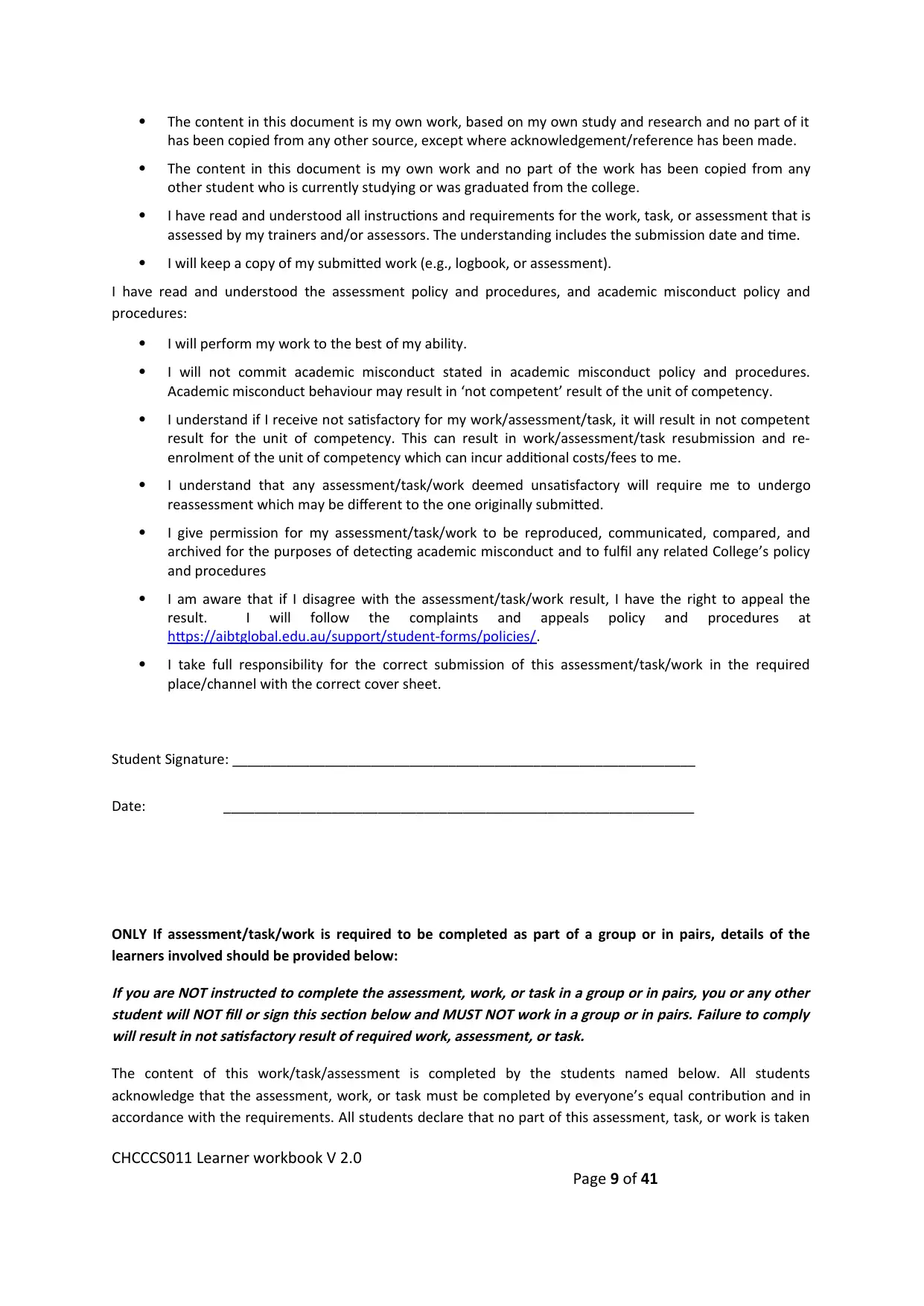
The content in this document is my own work, based on my own study and research and no part of it
has been copied from any other source, except where acknowledgement/reference has been made.
The content in this document is my own work and no part of the work has been copied from any
other student who is currently studying or was graduated from the college.
I have read and understood all instructions and requirements for the work, task, or assessment that is
assessed by my trainers and/or assessors. The understanding includes the submission date and time.
I will keep a copy of my submitted work (e.g., logbook, or assessment).
I have read and understood the assessment policy and procedures, and academic misconduct policy and
procedures:
I will perform my work to the best of my ability.
I will not commit academic misconduct stated in academic misconduct policy and procedures.
Academic misconduct behaviour may result in ‘not competent’ result of the unit of competency.
I understand if I receive not satisfactory for my work/assessment/task, it will result in not competent
result for the unit of competency. This can result in work/assessment/task resubmission and re-
enrolment of the unit of competency which can incur additional costs/fees to me.
I understand that any assessment/task/work deemed unsatisfactory will require me to undergo
reassessment which may be different to the one originally submitted.
I give permission for my assessment/task/work to be reproduced, communicated, compared, and
archived for the purposes of detecting academic misconduct and to fulfil any related College’s policy
and procedures
I am aware that if I disagree with the assessment/task/work result, I have the right to appeal the
result. I will follow the complaints and appeals policy and procedures at
https://aibtglobal.edu.au/support/student-forms/policies/.
I take full responsibility for the correct submission of this assessment/task/work in the required
place/channel with the correct cover sheet.
Student Signature: ____________________________________________________________
Date: _____________________________________________________________
ONLY If assessment/task/work is required to be completed as part of a group or in pairs, details of the
learners involved should be provided below:If you are NOT instructed to complete the assessment, work, or task in a group or in pairs, you or any other
student will NOT fill or sign this section below and MUST NOT work in a group or in pairs. Failure to comply
will result in not satisfactory result of required work, assessment, or task.
The content of this work/task/assessment is completed by the students named below. All students
acknowledge that the assessment, work, or task must be completed by everyone’s equal contribution and in
accordance with the requirements. All students declare that no part of this assessment, task, or work is taken
CHCCCS011 Learner workbook V 2.0
Page 9 of 41
has been copied from any other source, except where acknowledgement/reference has been made.
The content in this document is my own work and no part of the work has been copied from any
other student who is currently studying or was graduated from the college.
I have read and understood all instructions and requirements for the work, task, or assessment that is
assessed by my trainers and/or assessors. The understanding includes the submission date and time.
I will keep a copy of my submitted work (e.g., logbook, or assessment).
I have read and understood the assessment policy and procedures, and academic misconduct policy and
procedures:
I will perform my work to the best of my ability.
I will not commit academic misconduct stated in academic misconduct policy and procedures.
Academic misconduct behaviour may result in ‘not competent’ result of the unit of competency.
I understand if I receive not satisfactory for my work/assessment/task, it will result in not competent
result for the unit of competency. This can result in work/assessment/task resubmission and re-
enrolment of the unit of competency which can incur additional costs/fees to me.
I understand that any assessment/task/work deemed unsatisfactory will require me to undergo
reassessment which may be different to the one originally submitted.
I give permission for my assessment/task/work to be reproduced, communicated, compared, and
archived for the purposes of detecting academic misconduct and to fulfil any related College’s policy
and procedures
I am aware that if I disagree with the assessment/task/work result, I have the right to appeal the
result. I will follow the complaints and appeals policy and procedures at
https://aibtglobal.edu.au/support/student-forms/policies/.
I take full responsibility for the correct submission of this assessment/task/work in the required
place/channel with the correct cover sheet.
Student Signature: ____________________________________________________________
Date: _____________________________________________________________
ONLY If assessment/task/work is required to be completed as part of a group or in pairs, details of the
learners involved should be provided below:If you are NOT instructed to complete the assessment, work, or task in a group or in pairs, you or any other
student will NOT fill or sign this section below and MUST NOT work in a group or in pairs. Failure to comply
will result in not satisfactory result of required work, assessment, or task.
The content of this work/task/assessment is completed by the students named below. All students
acknowledge that the assessment, work, or task must be completed by everyone’s equal contribution and in
accordance with the requirements. All students declare that no part of this assessment, task, or work is taken
CHCCCS011 Learner workbook V 2.0
Page 9 of 41
⊘ This is a preview!⊘
Do you want full access?
Subscribe today to unlock all pages.

Trusted by 1+ million students worldwide

from or completed by any other student. If the assessment, work, or task cites or paraphrases information
from other sources, reference and acknowledgement of those sources must be provided.
Student 1:
Student ID: ____________________________________________________________
Student Name: ____________________________________________________________
Student Signature: ____________________________________________________________
Student 2:
Student ID: ____________________________________________________________
Student Name: ____________________________________________________________
Student Signature: ____________________________________________________________
Student 3:
Student ID: ____________________________________________________________
Student Name: ____________________________________________________________
Student Signature: ____________________________________________________________
Student 4:
Student ID: ____________________________________________________________
Student Name: ____________________________________________________________
Student Signature: ____________________________________________________________
CHCCCS011 Learner workbook V 2.0
Page 10 of 41
from other sources, reference and acknowledgement of those sources must be provided.
Student 1:
Student ID: ____________________________________________________________
Student Name: ____________________________________________________________
Student Signature: ____________________________________________________________
Student 2:
Student ID: ____________________________________________________________
Student Name: ____________________________________________________________
Student Signature: ____________________________________________________________
Student 3:
Student ID: ____________________________________________________________
Student Name: ____________________________________________________________
Student Signature: ____________________________________________________________
Student 4:
Student ID: ____________________________________________________________
Student Name: ____________________________________________________________
Student Signature: ____________________________________________________________
CHCCCS011 Learner workbook V 2.0
Page 10 of 41
Paraphrase This Document
Need a fresh take? Get an instant paraphrase of this document with our AI Paraphraser

Activities
Activity 1A
Estimated Time 40 Minutes
Objective To provide you with an opportunity to review Individualised plan and confirm
required equipment, processes and aids.
Activity Choose three aspects of care provision that are subject to personal
preference, and ask the client for their input on each, covering several areas
of the chosen categories.
You may refer to chapter 1.1 of the unit for ideas.
There are some of the three aspect which are effective and should take in
consideration which can be effective and allow to get better care and response
towards better quality of life. This may include personal hygiene, personal
appearance and meals. These are some of the aspect of care which should be
considered which can be client’s personal preferences.
Personal hygiene includes different area which may include washing, toileting
along with showering and bathing. Here, every client need to get better and
effective personal hygiene that can help to stay healthy and avoid the risk of
any type of infection. There is need to ask client about taking care of their
personal hygiene to live quality of life. There is need to ask client about their
preferences.
Personal appearance can also be considered in the individual lifestyle and
preferences. This can include shaving, hairstyle, makeup and skin treatment.
This is the one in which client should have their own interest and they like to
take their appearance according to their own. This can be helpful in dealing
with taking care of client health which can be associated with better wellbeing.
It can also help to build self-esteem that can be effective and help in getting
better care through staying in comfort. Through asking client preferences it can
help to perform well.
Meals should also be taken in consideration which can be effective and can
help to provide better learning and taking interest in client meal. This can allow
to take care of client health through advising for intake of healthy food. There is
need to ensure about dietary need along with preferences like vegetarian. This
can also include independent and assisted feeding. There is need to ask
question to client about their preferences and different breakfasts which can
include toast or cereals and many more. There is need to ask question about
client preferences about their meal which can help in taking well care.
CHCCCS011 Learner workbook V 2.0
Page 11 of 41
Activity 1A
Estimated Time 40 Minutes
Objective To provide you with an opportunity to review Individualised plan and confirm
required equipment, processes and aids.
Activity Choose three aspects of care provision that are subject to personal
preference, and ask the client for their input on each, covering several areas
of the chosen categories.
You may refer to chapter 1.1 of the unit for ideas.
There are some of the three aspect which are effective and should take in
consideration which can be effective and allow to get better care and response
towards better quality of life. This may include personal hygiene, personal
appearance and meals. These are some of the aspect of care which should be
considered which can be client’s personal preferences.
Personal hygiene includes different area which may include washing, toileting
along with showering and bathing. Here, every client need to get better and
effective personal hygiene that can help to stay healthy and avoid the risk of
any type of infection. There is need to ask client about taking care of their
personal hygiene to live quality of life. There is need to ask client about their
preferences.
Personal appearance can also be considered in the individual lifestyle and
preferences. This can include shaving, hairstyle, makeup and skin treatment.
This is the one in which client should have their own interest and they like to
take their appearance according to their own. This can be helpful in dealing
with taking care of client health which can be associated with better wellbeing.
It can also help to build self-esteem that can be effective and help in getting
better care through staying in comfort. Through asking client preferences it can
help to perform well.
Meals should also be taken in consideration which can be effective and can
help to provide better learning and taking interest in client meal. This can allow
to take care of client health through advising for intake of healthy food. There is
need to ensure about dietary need along with preferences like vegetarian. This
can also include independent and assisted feeding. There is need to ask
question to client about their preferences and different breakfasts which can
include toast or cereals and many more. There is need to ask question about
client preferences about their meal which can help in taking well care.
CHCCCS011 Learner workbook V 2.0
Page 11 of 41

Activity 1B
Estimated Time 60 Minutes
Objective To provide you with an opportunity to identify requirements outside of scope
of own role and seek support from relevant people.
Activity 1. Give an example of how you could confirm personal support
requirements with a client.
Identify an aspect of personal care and list the questions you could ask
the client and the choices they may have.
There is need to communicate effectively with client which can be helpful to
identify their needs and preference that can allow to take care of client
personal support requirement. Personal hygiene is the aspect of personal care
in which it is needed to take care about the health of patient which include
better oral hygiene and health care.
In this, there is need to ask client some question which are like-
How do you like to maintain oral hygiene?
Do you like to use mouth wash or brush?
Is it appropriate to use mouthwash twice a day?
Do you feel refreshed after using mouthwash?
How you would like to get better healthcare approach for improving
better oral health?
2. Identify a process that you are not qualified or trained to do.
What are the worst-case-scenario consequences for:
You?
The client(s)?
The organisation?
As a care professional, to take care of oral hygiene through providing treatment
is not under the qualification and applying those can lead to create negative
health impact for the client.
When patient needed oral healthcare professional in such situation providing
self-medication can create consequences for me that should be avoided. This
can also lead to create worst scenario for client which may lead to any health
consequences. Here, organisation can get negative response towards caring of
client which is also negative.
Identify a piece of equipment that you are not qualified or trained to use.
What are the worst-case-scenario consequences for:
You?
The client(s)?
The organisation?
CHCCCS011 Learner workbook V 2.0
Page 12 of 41
Estimated Time 60 Minutes
Objective To provide you with an opportunity to identify requirements outside of scope
of own role and seek support from relevant people.
Activity 1. Give an example of how you could confirm personal support
requirements with a client.
Identify an aspect of personal care and list the questions you could ask
the client and the choices they may have.
There is need to communicate effectively with client which can be helpful to
identify their needs and preference that can allow to take care of client
personal support requirement. Personal hygiene is the aspect of personal care
in which it is needed to take care about the health of patient which include
better oral hygiene and health care.
In this, there is need to ask client some question which are like-
How do you like to maintain oral hygiene?
Do you like to use mouth wash or brush?
Is it appropriate to use mouthwash twice a day?
Do you feel refreshed after using mouthwash?
How you would like to get better healthcare approach for improving
better oral health?
2. Identify a process that you are not qualified or trained to do.
What are the worst-case-scenario consequences for:
You?
The client(s)?
The organisation?
As a care professional, to take care of oral hygiene through providing treatment
is not under the qualification and applying those can lead to create negative
health impact for the client.
When patient needed oral healthcare professional in such situation providing
self-medication can create consequences for me that should be avoided. This
can also lead to create worst scenario for client which may lead to any health
consequences. Here, organisation can get negative response towards caring of
client which is also negative.
Identify a piece of equipment that you are not qualified or trained to use.
What are the worst-case-scenario consequences for:
You?
The client(s)?
The organisation?
CHCCCS011 Learner workbook V 2.0
Page 12 of 41
⊘ This is a preview!⊘
Do you want full access?
Subscribe today to unlock all pages.

Trusted by 1+ million students worldwide
1 out of 41
Related Documents
Your All-in-One AI-Powered Toolkit for Academic Success.
+13062052269
info@desklib.com
Available 24*7 on WhatsApp / Email
![[object Object]](/_next/static/media/star-bottom.7253800d.svg)
Unlock your academic potential
Copyright © 2020–2025 A2Z Services. All Rights Reserved. Developed and managed by ZUCOL.





